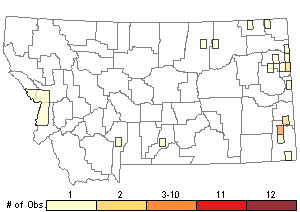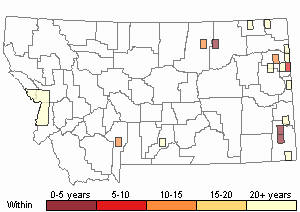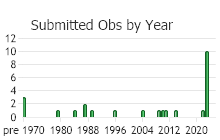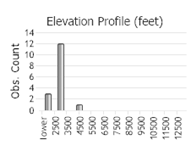View in other NatureServe Network Field Guides
NatureServe
Montana
Utah
Wyoming
Idaho
Wisconsin
British Columbia
South Carolina
Yukon
California
New York
American Elm - Ulmus americana
Native Species
Global Rank:
G4
State Rank:
S3S4
(see State Rank Reason below)
C-value:
9
Agency Status
USFWS:
USFS:
BLM:
External Links
State Rank Reason (see State Rank above)
Ulmus americana occurs in hardwood draws on the eastern edge of Montana. Native stands have been affected by woodcutting, overgrazing by livestock, and can exhibit significant dieback that may be related to drought or late spring freezes. Yet trees re-sprout after fire or harvesting. It has commonly been planted as an ornamental. While Dutch elm disease (Ceratocystis ulmi) has impacted planted trees in towns, there are no reports of it killing native populations in eastern Montana. Populations appear stable, but current data is needed on locations, population age structure and sizes, and threats.
- Details on Status Ranking and Review
Range Extent
ScoreF - 20,000-200,000 sq km (~8,000-80,000 sq mi)
Area of Occupancy
ScoreD - 6-25 4-km2 grid cells
Number of Populations
ScoreC - 21 - 80
Number of Occurrences or Percent Area with Good Viability / Ecological Integrity
ScoreC - Few (4-12) occurrences with excellent or good viability or ecological integrity
Environmental Specificity
ScoreC - Moderate. Generalist or community with some key requirements scarce
Threats
ScoreD - Low
CommentThreat categories include: Logging & wood harvesting. Hardwood draws in eastern Montana are the source of fenceposts and firewood, although stumps can sprout back from cuttings.
General Description
Trees to 15 m with gray to brown, fissured bark. Twigs pubescent with acute buds. Leaf blades elliptic with an asymmetric base, 7–12 cm long, scabrous above with twice serrate margins. Flowers on drooping pedicels 1–2 cm long; calyx with 7 to 9 lobes; anthers red. Samaras ovate, yellowish, about 1 cm long (
Lesica et al. 2012. Manual of Montana Vascular Plants. BRIT Press. Fort Worth, TX).
Species Range
Montana Range
Range Descriptions

 Native
Native
Range Comments
Easternmost tier of counties in MT; southern Canada east from MB to NB and NS; throughout throughout eastern US east of the Longitude 100 W (Sherman-Broyles et al. 1997 in Fl. N. Amer. Vol. 3).
Observations in Montana Natural Heritage Program Database
Number of Observations: 33
(Click on the following maps and charts to see full sized version)
Map Help and Descriptions
Relative Density

Recency



 (Observations spanning multiple months or years are excluded from time charts)
(Observations spanning multiple months or years are excluded from time charts)
Habitat
In Montana it grows in woodlands within ravines or along rivers and streams; plains to eastern deciduous forests (Sherman-Broyles et al. 1997 in Fl. N. Amer. Vol. 3).
National Vegetation Classification System Groups Associated with this Species
Forest and Woodland
Deciduous Forest and Woodland
Wetland and Riparian
Riparian and Wetland Forest
Ecology
In Montana American elm can be co-dominant with green ash (Fraxinus pensylvanica). Where they both occur American elm averaged 32% in canopy cover in eastern Montana and 29% in southwestern North Dakota (Lesica and Marlow 2013).
Reproductive Characteristics
It is shallow-rooted and grows on floodplains (Lesica and Marlow 2013). Flowers develop before the leaves bud out in late May (in Montana), and winged seeds disperse in June (in Montana) (Lesica and Marlow 2013). It can sprout from the base when cut or burned.
Management
In Montana American elm trees can reach 100 feet in height and 70 inches in diameter (Lesica and Marlow 2013). It is believed to be capable of living to 200 years (Lesica and Marlow 2013). Its wood is hard and strong; structurally trees often exhibit large-diameter branches and many small twigs with few intermediate branches (Lesica and Marlow 2013). It was commonly planted as an ornamental (Lesica and Marlow 2013), particularly along roads and boulevards.
Within green ash woodlands, American elm are susceptible to dieback, which may be related to drought, late-spring freezes, or another cause (Lesica and Marlow 2013).
Throughout much of the U.S. Dutch elm disease (Ceratocystis ulmi) has killed native and planted elms. In eastern Montana many of the planted elms have succumbed to Dutch elm disease, but there have been no reports from native stands (Lesica and Marlow 2013).
Stewardship Responsibility
References
- Literature Cited AboveLegend:
 View Online Publication
View Online Publication Lesica, P. and C. Marlow. 2013. Green Ash Woodlands, A Review. Research Bulletin No. 4601. Montana State University Extension. Bozeman, MT. 19 pp.
Lesica, P. and C. Marlow. 2013. Green Ash Woodlands, A Review. Research Bulletin No. 4601. Montana State University Extension. Bozeman, MT. 19 pp. Lesica, P., M.T. Lavin, and P.F. Stickney. 2012. Manual of Montana Vascular Plants. Fort Worth, TX: BRIT Press. viii + 771 p.
Lesica, P., M.T. Lavin, and P.F. Stickney. 2012. Manual of Montana Vascular Plants. Fort Worth, TX: BRIT Press. viii + 771 p. Sherman-Broyles, S. L., W. T. Barker, and L. M. Schulz. 1997. Ulmaceae (pp. 368-371). In: Flora of North America Editorial Committee, eds. 1993+. Flora of North America north of Mexico. 20+ volumes. New York and Oxford. Volume 3. 590 pp. + xxiii.
Sherman-Broyles, S. L., W. T. Barker, and L. M. Schulz. 1997. Ulmaceae (pp. 368-371). In: Flora of North America Editorial Committee, eds. 1993+. Flora of North America north of Mexico. 20+ volumes. New York and Oxford. Volume 3. 590 pp. + xxiii.
- Additional ReferencesLegend:
 View Online Publication
View Online Publication
Do you know of a citation we're missing? Boggs, K. W. 1984. Succession in riparian communities of the lower Yellowstone River, Montana. M.S. Thesis. Montana State University, Bozeman, 107 pp.
Boggs, K. W. 1984. Succession in riparian communities of the lower Yellowstone River, Montana. M.S. Thesis. Montana State University, Bozeman, 107 pp. Lesica, P., M.T. Lavin, and P.F. Stickney. 2022. Manual of Montana Vascular Plants, Second Edition. Fort Worth, TX: BRIT Press. viii + 779 p.
Lesica, P., M.T. Lavin, and P.F. Stickney. 2022. Manual of Montana Vascular Plants, Second Edition. Fort Worth, TX: BRIT Press. viii + 779 p. Little, E.L., Jr. 1979. Checklist of United States trees (native and naturalized). Agriculture Handbook No. 541. U.S. Forest Service, Washington, D.C. 375 pp.
Little, E.L., Jr. 1979. Checklist of United States trees (native and naturalized). Agriculture Handbook No. 541. U.S. Forest Service, Washington, D.C. 375 pp. Rauscher, R.L. 1995. Deer use of irrigated alfalfa along the Yellowstone River, Custer County, Montana. M.Sc. Thesis. Bozeman, MT: Montana State University. 50 p.
Rauscher, R.L. 1995. Deer use of irrigated alfalfa along the Yellowstone River, Custer County, Montana. M.Sc. Thesis. Bozeman, MT: Montana State University. 50 p.
- Web Search Engines for Articles on "American Elm"





